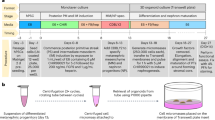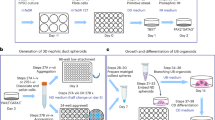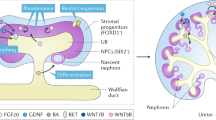Abstract
Kidney cells and tissues derived from human pluripotent stem cells (hPSCs) may enable organ regeneration, disease modeling and drug screening. We report an efficient, chemically defined protocol for differentiating hPSCs into multipotent nephron progenitor cells (NPCs) that can form nephron-like structures. By recapitulating metanephric kidney development in vitro, we generate SIX2+SALL1+WT1+PAX2+ NPCs with 90% efficiency within 9 days of differentiation. The NPCs possess the developmental potential of their in vivo counterparts and form PAX8+LHX1+ renal vesicles that self-organize into nephron structures. In both two- and three-dimensional culture, NPCs form kidney organoids containing epithelial nephron-like structures expressing markers of podocytes, proximal tubules, loops of Henle and distal tubules in an organized, continuous arrangement that resembles the nephron in vivo. We also show that this organoid culture system can be used to study mechanisms of human kidney development and toxicity.
This is a preview of subscription content, access via your institution
Access options
Subscribe to this journal
Receive 12 print issues and online access
$209.00 per year
only $17.42 per issue
Buy this article
- Purchase on Springer Link
- Instant access to full article PDF
Prices may be subject to local taxes which are calculated during checkout






Similar content being viewed by others
References
Coresh, J. et al. Prevalence of chronic kidney disease in the United States. J. Am. Med. Assoc. 298, 2038–2047 (2007).
Herzlinger, D., Koseki, C., Mikawa, T. & al-Awqati, Q. Metanephric mesenchyme contains multipotent stem cells whose fate is restricted after induction. Development 114, 565–572 (1992).
Self, M. et al. Six2 is required for suppression of nephrogenesis and progenitor renewal in the developing kidney. EMBO J. 25, 5214–5228 (2006).
Kobayashi, A. et al. Six2 defines and regulates a multipotent self-renewing nephron progenitor population throughout mammalian kidney development. Cell Stem Cell 3, 169–181 (2008).
Boyle, S. et al. Fate mapping using Cited1-CreERT2 mice demonstrates that the cap mesenchyme contains self-renewing progenitor cells and gives rise exclusively to nephronic epithelia. Dev. Biol. 313, 234–245 (2008).
Hinchliffe, S.A., Sargent, P.H., Howard, C.V., Chan, Y.F. & van Velzen, D. Human intrauterine renal growth expressed in absolute number of glomeruli assessed by the disector method and Cavalieri principle. Lab. Invest. 64, 777–784 (1991).
Humphreys, B.D. et al. Intrinsic epithelial cells repair the kidney after injury. Cell Stem Cell 2, 284–291 (2008).
Georgas, K.M., Chiu, H.S., Lesieur, E., Rumballe, B.A. & Little, M.H. Expression of metanephric nephron-patterning genes in differentiating mesonephric tubules. Dev. Dyn. 240, 1600–1612 (2011).
Kim, D. & Dressler, G.R. Nephrogenic factors promote differentiation of mouse embryonic stem cells into renal epithelia. J. Am. Soc. Nephrol. 16, 3527–3534 (2005).
Vigneau, C. et al. Mouse embryonic stem cell-derived embryoid bodies generate progenitors that integrate long term into renal proximal tubules in vivo. J. Am. Soc. Nephrol. 18, 1709–1720 (2007).
Morizane, R., Monkawa, T. & Itoh, H. Differentiation of murine embryonic stem and induced pluripotent stem cells to renal lineage in vitro. Biochem. Biophys. Res. Commun. 390, 1334–1339 (2009).
Narayanan, K. et al. Human embryonic stem cells differentiate into functional renal proximal tubular-like cells. Kidney Int. 83, 593–603 (2013).
Morizane, R. et al. Kidney specific protein-positive cells derived from embryonic stem cells reproduce tubular structures in vitro and differentiate into renal tubular cells. PLoS One 8, e64843 (2014).
Mae, S. et al. Monitoring and robust induction of nephrogenic intermediate mesoderm from human pluripotent stem cells. Nat. Commun. 4, 1367 (2013).
Xia, Y. et al. Directed differentiation of human pluripotent cells to ureteric bud kidney progenitor-like cells. Nat. Cell Biol. 15, 1507–1515 (2013).
Lam, A.Q., Freedman, B.S. & Bonventre, J.V. Directed differentiation of pluripotent stem cells to kidney cells. Semin. Nephrol. 34, 445–461 (2014).
Taguchi, A. et al. Redefining the in vivo origin of metanephric nephron progenitors enables generation of complex kidney structures from pluripotent stem cells. Cell Stem Cell 14, 53–67 (2014).
Takasato, M. et al. Directing human embryonic stem cell differentiation towards a renal lineage generates a self-organizing kidney. Nat. Cell Biol. 16, 118–126 (2014).
Kang, M. & Han, Y.M. Differentiation of human pluripotent stem cells into nephron progenitor cells in a serum and feeder free system. PLoS One 9, e94888 (2014).
Lam, A.Q. et al. Rapid and efficient differentiation of human pluripotent stem cells into intermediate mesoderm that forms tubules expressing kidney proximal tubular markers. J. Am. Soc. Nephrol. 25, 1211–1225 (2014).
Imberti, B. et al. Renal progenitors derived from human iPSCs engraft and restore function in a mouse model of acute kidney injury. Sci. Rep. 5, 8826 (2015).
Grote, D., Souabni, A., Busslinger, M. & Bouchard, M. Pax 2/8-regulated Gata 3 expression is necessary for morphogenesis and guidance of the nephric duct in the developing kidney. Development 133, 53–61 (2006).
Attia, L., Yelin, R. & Schultheiss, T.M. Analysis of nephric duct specification in the avian embryo. Development 139, 4143–4151 (2012).
Lengerke, C. et al. BMP and Wnt specify hematopoietic fate by activation of the Cdx-Hox pathway. Cell Stem Cell 2, 72–82 (2008).
Liu, P. et al. Requirement for Wnt3 in vertebrate axis formation. Nat. Genet. 22, 361–365 (1999).
Iimura, T. & Pourquié, O. Collinear activation of Hoxb genes during gastrulation is linked to mesoderm cell ingression. Nature 442, 568–571 (2006).
Deschamps, J. & van Nes, J. Developmental regulation of the Hox genes during axial morphogenesis in the mouse. Development 132, 2931–2942 (2005).
Osafune, K. et al. Marked differences in differentiation propensity among human embryonic stem cell lines. Nat. Biotechnol. 26, 313–315 (2008).
Bock, C. et al. Reference Maps of human ES and iPS cell variation enable high-throughput characterization of pluripotent cell lines. Cell 144, 439–452 (2011).
Mahlapuu, M., Ormestad, M., Enerbäck, S. & Carlsson, P. The forkhead transcription factor Foxf1 is required for differentiation of extra-embryonic and lateral plate mesoderm. Development 128, 155–166 (2001).
Zimmerman, L.B., De Jesús-Escobar, J.M. & Harland, R.M. The Spemann organizer signal noggin binds and inactivates bone morphogenetic protein 4. Cell 86, 599–606 (1996).
Barak, H. et al. FGF9 and FGF20 maintain the stemness of nephron progenitors in mice and man. Dev. Cell 22, 1191–1207 (2012).
Narlis, M., Grote, D., Gaitan, Y., Boualia, S.K. & Bouchard, M. Pax2 and pax8 regulate branching morphogenesis and nephron differentiation in the developing kidney. J. Am. Soc. Nephrol. 18, 1121–1129 (2007).
Kispert, A., Vainio, S. & McMahon, A.P. Wnt-4 is a mesenchymal signal for epithelial transformation of metanephric mesenchyme in the developing kidney. Development 125, 4225–4234 (1998).
Barasch, J., Pressler, L., Connor, J. & Malik, A. A ureteric bud cell line induces nephrogenesis in two steps by two distinct signals. Am. J. Physiol. 271, F50–F61 (1996).
Carroll, T.J., Park, J.S., Hayashi, S., Majumdar, A. & McMahon, A.P. Wnt9b plays a central role in the regulation of mesenchymal to epithelial transitions underlying organogenesis of the mammalian urogenital system. Dev. Cell 9, 283–292 (2005).
Potter, S.S., Hartman, H.A., Kwan, K.M., Behringer, R.R. & Patterson, L.T. Laser capture-microarray analysis of Lim1 mutant kidney development. Genesis 45, 432–439 (2007).
Park, J.S. et al. Six2 and Wnt regulate self-renewal and commitment of nephron progenitors through shared gene regulatory networks. Dev. Cell 23, 637–651 (2012).
Nouwen, E.J., Dauwe, S., van der Biest, I. & De Broe, M.E. Stage- and segment-specific expression of cell-adhesion molecules N-CAM, A-CAM, and L-CAM in the kidney. Kidney Int. 44, 147–158 (1993).
Nakai, S. et al. Crucial roles of Brn1 in distal tubule formation and function in mouse kidney. Development 130, 4751–4759 (2003).
Georgas, K. et al. Use of dual section mRNA in situ hybridisation/immunohistochemistry to clarify gene expression patterns during the early stages of nephron development in the embryo and in the mature nephron of the adult mouse kidney. Histochem. Cell Biol. 130, 927–942 (2008).
Georgas, K. et al. Analysis of early nephron patterning reveals a role for distal RV proliferation in fusion to the ureteric tip via a cap mesenchyme-derived connecting segment. Dev. Biol. 332, 273–286 (2009).
Cheng, H.T. et al. Gamma-secretase activity is dispensable for mesenchyme-to-epithelium transition but required for podocyte and proximal tubule formation in developing mouse kidney. Development 130, 5031–5042 (2003).
Cheng, H.T. et al. Notch2, but not Notch1, is required for proximal fate acquisition in the mammalian nephron. Development 134, 801–811 (2007).
Uchino, S. et al. Acute renal failure in critically ill patients: a multinational, multicenter study. J. Am. Med. Assoc. 294, 813–818 (2005).
Whiting, P.H. & Brown, P.A. The relationship between enzymuria and kidney enzyme activities in experimental gentamicin nephrotoxicity. Ren. Fail. 18, 899–909 (1996).
Vaidya, V.S. et al. Kidney injury molecule-1 outperforms traditional biomarkers of kidney injury in preclinical biomarker qualification studies. Nat. Biotechnol. 28, 478–485 (2010).
Taguchi, A. & Nishinakamura, R. Nephron reconstitution from pluripotent stem cells. Kidney Int. 87, 894–900 (2015).
Lancaster, M.A. et al. Cerebral organoids model human brain development and microcephaly. Nature 501, 373–379 (2013).
McCracken, K.W. et al. Modelling human development and disease in pluripotent stem-cell-derived gastric organoids. Nature 516, 400–404 (2014).
Freedman, B.S. et al. Reduced ciliary polycystin-2 in induced pluripotent stem cells from polycystic kidney disease patients with PKD1 mutations. J. Am. Soc. Nephrol. 24, 1571–1586 (2013).
Acknowledgements
The authors thank V. Bijol for providing electron microscopy images of normal human kidneys, L. Racusen (Johns Hopkins Hospital) for HKC-8, J. Barasch (Columbia University) for a mouse ureteric bud cell line, and A.P. McMahon (University of Southern California) for NIH3T3-Wnt4. This study was supported by US National Institutes of Health (NIH) grants R37 DK039773 and R01 DK072381 (J.V.B.); Grant-in-Aid for JSPS (Japan Society for the Promotion of Science); Postdoctoral Fellowship for Research Abroad (R.M.); American Heart Association grant 11FTF7320023 (A.Q.L.); Harvard Stem Cell Institute (A.Q.L., J.V.B. and M.T.V.); and NIH DK102826 and National Kidney Foundation Young Investigator Grant (B.S.F.).
Author information
Authors and Affiliations
Contributions
R.M. and J.V.B. formulated the strategy for this study. R.M. designed and performed experiments. R.M., A.Q.L. and J.V.B. wrote the manuscript. A.Q.L. and B.S.F. performed nephrotoxicity assays. S.K. performed real-time PCR. M.T.V. and J.V.B. helped to design experiments. All authors helped to interpret the results.
Corresponding authors
Ethics declarations
Competing interests
J.V.B. is a co-inventor on KIM-1 patents, which have been licensed by Partners Healthcare to several companies. He has received royalty income from Partners Healthcare. J.V.B. or his family has received income for consulting from companies interested in biomarkers: Sekisui, Millennium, Johnson & Johnson and Novartis.
Integrated supplementary information
Supplementary Figure 1 Metanephric development and published protocols
(a) A schematic illustration of intermediate mesoderm and subsequent differentiation into mesonephros and metanephros. (b) The summary and comparison of published protocols and our new protocol. Takasato et al. Nat Cell Biol. 2014. Taguchi et al. Cell Stem Cell. 2014. RA: retinoic acid.
Supplementary Figure 2 Adjustment of the dose and CHIR treatment time
(a) A schematic illustration of primitive streak and subsequent differentiation into each mesoderm lineage. (b) Pluripotency was evaluated by staining with OCT4 and SOX2 before the differentiation. hESCs differentiated with CHIR 5 μM were positive for T and TBX6 on day 1.5 of differentiation, but cells did not stain for HOXD11. Scale bars: 200 μm. (c) Immunocytochemistry on day 4 of the differentiation with CHIR (3 to 10 μM). Sustained TBX6 expression was observed when the cells were differentiated with high doses of CHIR (7-10 μM). Scale bar: 100 μm. (d) Real-time PCR for MIXL1 in hESCs from day 0 to 7. hESCs were differentiated with CHIR 8 μM for 4 days, and activin 10 ng/ml for 3 days. MIXL1, another marker for primitive streak also showed sustained expression at least until day 4 of the differentiation. Expression returned to very low levels by day 7. n=2. (e) Staining with WT1 and HOXD11 on day 7 of the differentiation. hESCs were differentiated with CHIR 8 μM for 4 days and subsequently with the basic medium (ARPMI) for 3 days. Cells expressed WT1, but not HOXD11. Scale bar 100 μm.
Supplementary Figure 3 Protocol adjustment in hiPSCs
(a) Comparison of CHIR dose in T expression on day 4. A slightly higher dose of CHIR was required for sustained T expression in hiPSCs on day 4. (b) Immunocytochemistry for T, TBX6 or FOXF1 on day 4 of differentiation. hESCs were differentiated with CHIR 8 μM, and hiPSCs were differentiated with CHIR 10 μM. Notably, FOXF1 was negative in hESCs, but was positive in hiPSCs. (c) The tested protocol and representative immunocytochemistry in hiPSCs. Noggin at >5 ng/ml suppressed FOXF1 expression on day 4. To induce WT1 expression on day 7, Noggin 5 ng/ml was optimal. (d) The differentiation protocol and staining for FOXF1 on day 4, and for WT1 on day 7 in hESCs. Either additional Noggin or BMP4 significantly suppressed WT1 expression on day 7, and BMP4 induced FOXF1 expression on day 4, suggesting endogenous BMP4 signal is optimal in hESCs with CHIR treatment alone. (e) The protocol and staining with WT1 and HOXD11 on day 7 in hiPSCs. CHIR 10 μM + Noggin 5 ng/ml followed by activin 10 ng/ml showed the most efficient differentiation into WT1+HOXD11+ cells in hiPSCs. Scale bars: 100 μm.
Supplementary Figure 4 Spontaneous differentiation of SIX2+ cells into nephrons and growth factor screening in 3D culture
(a) Staining with PAX8 and LHX1 in hESCs on day 10 of the differentiation. hESCs were differentiated with CHIR 8 μM for 4 days, activn 10 ng/ml for 3 days, and FGF9 10 ng/ml for 3 days. Sporadic expression of LHX1 was observed in PAX8+ cells. Scale bar: 50 μm. (b) Brighfield imaging for hESCs on day 10 and 21 of the differentiation. FGF9 was withdrawn on day 10, and cells were cultured in the basic medium by day 21. Scale bars: 50 μm. (c) Brightfield and immunocytochemistry for LTL and NPHS1 in hESCs on day 28 of the differentiation. Scale bar: 50 μm. (d) The protocol for growth factor screening. Cells were replated to 3D culture on day 10, and the listed growth factors and small molecules were tested. (e) The number of LTL+ tubules in the organoids. HGF showed a tendency to increase LTL+ tubules. n=2. (f) Brightfield imaging of 3D co-culture.with an ureteric bud cell sphere. Scale bar: 100 μm. (g) Whole-mountstaining for LTL in the organoids on day 16. Scale bar: 100 μm. (h) Immunohistochemistry of the organoids on day 16. Scale bars: 50 μm. LTL: lotus tetragonolobus lectin. NPHS1: Nephrin.
Supplementary Figure 5 Screening for growth factors and small molecules to induce renal vesicles
(a, b) The tested protocols for renal vesicle induction. (c) Immunocytochemistry for SIX2 and LHX1 in structures on day 14 of differentiation. Transient treatment with CHIR 3 μM from day 9 to 11, in combination with FGF9 10 ng/ml from day 7 to 14, increased the number of LHX1+ cells and suppressed SIX2 expression, suggesting mesenchymal epithelial transition. Scale bars: 50 μm. REGM: renal cell growth medium (Lonza, #CC-3190).
Supplementary Figure 6 Kidney development analysis
(a) DAPT was used to suppress Notch signaling from day 14 to 21. (b) CDH1, PODXL and LTL expression on day 21 in cells derived from hESCs in 2D culture. Scale bars: 50 μm. (c) Percentage of LTL+ nephron structures in control and DAPT-treated on day 21. The nephron number was counted as CDH1+ tubules from 10 fields (x20 magnification) of each sample (n=2). CDH1: Cadherin-1 (E-cadherin). PODXL: Podocalyxin-like (Podocalyxin).
Supplementary Figure 7 Nephrotoxic assay
(A) The protocol for the nephrotoxic assay. Gentamicin 5 mg/ml was added from day 21 to 23. (B) Whole-mount staining on day 23 for CDH1, KIM-1 and LTL in kidney organoids derived from hESCs. Scale bars: 50 μm. CDH1: cadherin-1 (E-cadherin). PODXL: podocalyxin-like (Podocalyxin). LTL: lotus tetragonolobus lectin. KIM-1: kidney injury molecule-1.
Supplementary information
Supplementary Figures and Tables
Supplementary Figures 1–7 and Supplementary Tables 1–3 (PDF 5321 kb)
Rights and permissions
About this article
Cite this article
Morizane, R., Lam, A., Freedman, B. et al. Nephron organoids derived from human pluripotent stem cells model kidney development and injury. Nat Biotechnol 33, 1193–1200 (2015). https://doi.org/10.1038/nbt.3392
Received:
Accepted:
Published:
Issue Date:
DOI: https://doi.org/10.1038/nbt.3392
This article is cited by
-
Insights on Three Dimensional Organoid Studies for Stem Cell Therapy in Regenerative Medicine
Stem Cell Reviews and Reports (2024)
-
Human ureteric bud organoids recapitulate branching morphogenesis and differentiate into functional collecting duct cell types
Nature Biotechnology (2023)
-
Replacing renal function using bioengineered tissues
Nature Reviews Bioengineering (2023)
-
A proof-of-concept assay for quantitative and optical assessment of drug-induced toxicity in renal organoids
Scientific Reports (2023)
-
Cisplatin nephrotoxicity: new insights and therapeutic implications
Nature Reviews Nephrology (2023)



